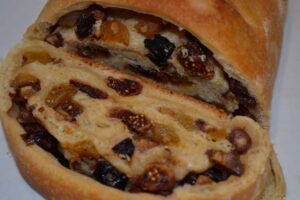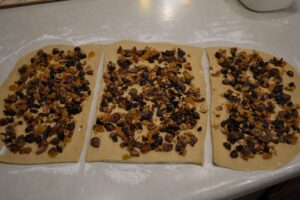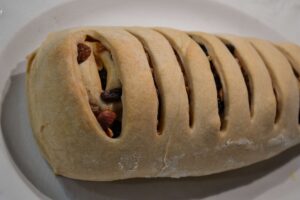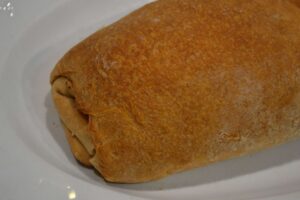This is the name we’ve given to a holiday family favorite. Or at least our version of it. “Fresh-baked, angelic, delicious Bread Crusto.” It can be made many different ways, but it’s based on rolling up a layer of dried fruit filling inside a tasty bread.
We begin with Julia Child’s “The Way to Cook” brioche recipe for the dough. It’s superb for this.
Start by getting the yeast ready, mixing it up and letting it get going for a few minutes:
1 packet (2.25 tsp) of yeast
3 Tbsp of warm water (not hot)
2 tsp sugar
Next, prepare the bulk of the mix:
3.5 C all-purpose flour
1.5 tsp salt
1/3 C sugar
1.5 sticks (6 oz. ) butter
4 eggs
1/3 C milk
Mix the dough and yeast mixture together; add more milk if needed. We use a bread machine on manual. Julia Child provided many other options for making (and using) this special, multi-use dough.
While the dough is mixing and rising (about 2 hr in the machine), we make the filling. It’s mostly dried fruit. We have used cherries, apricots, figs, plums, and dates. We also usually add some nuts—slivered almonds or chopped walnuts. It’s a different blend every time. Into a saucepan on low heat put:
3-4 C chopped dried fruit & nuts
½ C butter
½ C brown sugar
Mix it well as the butter and sugar melt together. Let it cool to be just warm before applying to the rolled out dough. Once we have the partially risen dough, we roll it out into a thin piece a little over two feet wide and one foot high (roughly). Then we spread the fruit mixture onto it evenly.
For ease of handling, breaking this creation into three pieces is helpful. We make two paths in the fruit and cut the whole into thirds, width-ways. Then we roll up each piece, shaping it to be fairly even, and place it on a cookie sheet. When all three are aboard, put a dish towel over them and put them in a warm place to rise for a few hours. Oh—you can cut lightly into the top crossways every inch or so to decoratively show some of the filled interior in the final product if you like. Or not. When about ready to bake, turn the oven on at 350º F.
Because we vary this so much, we always have to bake it with careful attention. If the loaves didn’t rise much, they cook fast, and 15-20 minutes is adequate. If the loaves are full and puffy, then it takes longer, but if you’re not careful the outside gets rather dry and the inside can remain a little doughy. We are not shy about sacrificing slices off the third loaf to check how it’s going. Eating Bread Crusto while it’s still hot is heaven. Because there is so much butter in the dough, the classic knife-insertion technique for doneness doesn’t work.
This year we tried a sugar-free version (using just ~3 Tbsp in the dough so it would rise), and our good friend Jennifer Jolis, chef extraordinaire, stopped by and suggested tenting the loaves in aluminum foil for the last bit. These came out well when tenting at ~20 min and baking for another ~10 min., then letting them rest, still tented, to cool. It turns out that this recipe is still super good with almost no sugar. We look forward to more experimenting. We haven’t had one turn out badly yet.




Oh yeah, and something to consider in your experimenting – plump up that dried fruit in a warm, boozy soak. Bourbon or brandy or cognac or rum all come to mind. If you don’t want the booze, soak them in some hot water. Over night is great, but sometimes a few hours is enough.
Remember Patty’s fruit cake – she started booze-soaking her dried fruits the day after Thanksgiving!
We always soak the figs for Scootie in hot water before making, but we only soak for this recipe if the dried fruits are particularly dry. They’re chopped finely enough that the small chewy bits are nice. (I detest fruit cake. Yuck.)
YUM!
Use a thermometer instead of sacrificing.
190 – 200 degrees is good for baked breads.
We’ll try that next time!